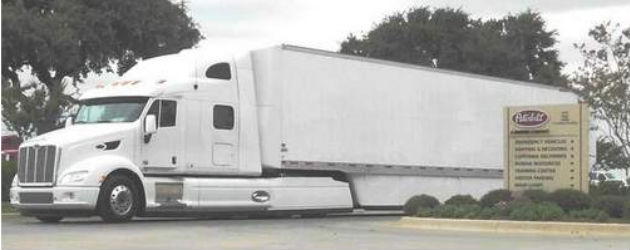Cummins/Peterbilt SuperTruck shows 54% improvement in fuel economy
 Courtesy of Green Car Congress: Cummins Inc. and Peterbilt Motors Company, a division of PACCAR, released test results showing their demonstration SuperTruck tractor-trailer achieved a 54% increase in fuel economy, averaging nearly 10 mpg US (23.5 l/100 km) under real world driving conditions.
Courtesy of Green Car Congress: Cummins Inc. and Peterbilt Motors Company, a division of PACCAR, released test results showing their demonstration SuperTruck tractor-trailer achieved a 54% increase in fuel economy, averaging nearly 10 mpg US (23.5 l/100 km) under real world driving conditions.
In addition, the truck also demonstrated a 61% improvement in freight efficiency during testing compared to a baseline truck driving the same route. Freight efficiency is based on payload weight and fuel efficiency expressed in ton-miles per gallon.
Cummins is a prime contractor leading one of four vertical teams under the Department of Energy’s SuperTruck project, one of several initiatives under the 21st Century Truck Partnership. (Earlier post.) Objectives for the program, which runs from April 2010 through April 2014, include:
* Demonstrate 50% thermal efficiency improvements in test cell;
* Demonstrate a 50% drive-cycle freight efficiency improvement;
* Demonstrate 68% freight efficiency improvement on 24hr cycle; and
* Scope and demonstrate improvements for a 55% engine efficiency.
 Results. The results reported reflect the second major demonstration milestone in the SuperTruck project—the attainment of 50% drive-cycle freight efficiency. Still to come are the 24-hour Cycle Freight Efficiency Demonstration (December 2013) and the 55% BTE scoping and demonstration (Aril 2014).
Results. The results reported reflect the second major demonstration milestone in the SuperTruck project—the attainment of 50% drive-cycle freight efficiency. Still to come are the 24-hour Cycle Freight Efficiency Demonstration (December 2013) and the 55% BTE scoping and demonstration (Aril 2014).
During the reported test, the Class 8 Peterbilt 587 powered by a Cummins ISX15 engine averaged 9.9 mpg (23.8 l/100 km) during testing last fall on US Route 287 between Fort Worth and Vernon, Texas. The testing was conducted over 11 runs meeting SAE International test standards along a 312-mile route. The tractor-trailer had a combined gross weight of 65,000 lbs.
Today’s long-haul trucks typically achieve between 5.5 and 6.5 mpg (42.8 and 36.2 l/100 km). The 54% increase in fuel economy would save about $25,000 annually based on today’s diesel fuel prices for a long-haul truck traveling 120,000 miles per year. It would also translate into a 35% reduction in annual greenhouse gases per truck.
The reported 61% freight efficiency significantly exceeded the program goal of 50% for this demonstration.
Cummins1
Approach to technology improvements. Source: Cummins. Click to enlarge.
The SuperTruck. The SuperTruck developed by the two companies and their partners features a higher-efficiency engine and an aerodynamic tractor-trailer that significantly reduces drag. The truck also includes a Rankine cycle waste heat recovery system; electronic controls that use route information to optimize fuel use; tires with lower rolling resistance; and lighter-weight material throughout.
Cummins personnel and their partners in other companies and research institutions have been focused on the engine and its integration with the powertrain. To raise the thermal efficiency of the engine, they worked with increasing the compression ratio, and optimizing piston bowl shape, injectors and calibration.
Cummins2
Sources of increased engine thermal efficiency. Source: Cummins. Click to enlarge.
Gas flow improvements included a lower delta-P EGR loop and turbocharger match. Parasitic power reductions addressed cylinder kit friction and cooling pump power.
In addition to the truck’s exterior, Peterbilt and its partners have been working on improvements in the drivetrain, the idle management system, weight reduction and vehicle climate control. Eaton’s advanced transmission facilitates further engine downspeeding for additional fuel economy benefits.
Cummins, Peterbilt and their program partners will have invested $38.8 million in private funds over the four-year life of their SuperTruck program, with critical support coming through awarded matching grants from the Department of Energy’s Vehicle Technologies Program.
Testing will continue in 2013 on a new Peterbilt 579 that Cummins and Peterbilt are confident will take what has been achieved so far to even higher levels. The testing will address use of the tractor-trailer over a 24-hour period; including periods when drivers are at rest but still need power for such things as air conditioning and small appliances.
Category: Fuel & Oil, General Update









